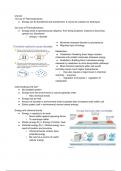Summary
Summary University of Waterloo: BIOL130 Unit 2A Notes (Typed)
- Course
- BIOL130 (BIOL130)
- Institution
- University Of Waterloo (UW )
BIOL130 is an introductory course at the University of Waterloo for all biology-related courses. This course is an introduction to cell biology. Unit 2A is about thermodynamics and catalysts. The main topics in this unit include energy transfer in living organisms, Gibbs free energy, coupled reacti...
[Show more]



